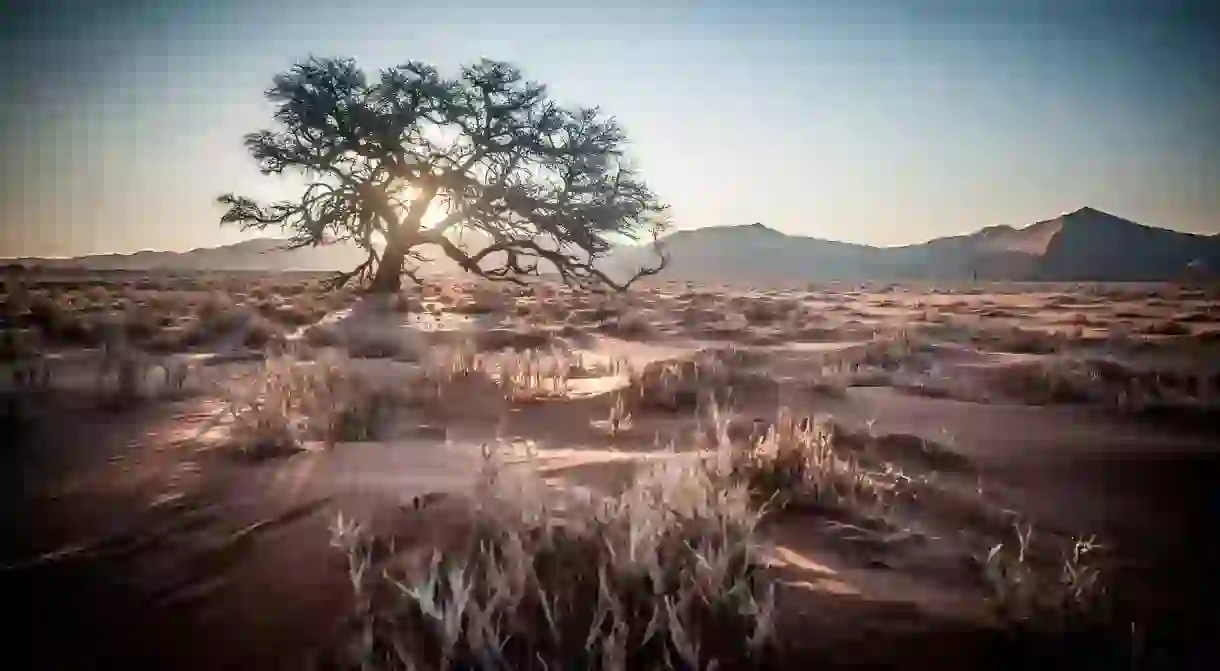Breathtaking Natural Landscapes in Namibia

There is no shortage of stunning natural scenery in Namibia, and the country presents quintessential African beauty around just about every turn. Its variety is astounding and its vistas quite breathtaking, while the quiet stillness slows down the pace and leaves time for reflection and inspiration. Here are some of Namibia’s natural highlights that contribute to its eternal appeal.
Namib Naukluft National Park
Park

Popa Falls
Natural Feature
One of the highlights of the western Caprivi is the Popo Falls, a series of beautiful white-water rapids that cascade gently and melodically down quartzite ledges. The falls form part of the Okavango River and cover a breadth of over one kilometre (0.6 miles) before descending down rocky outcrops into the Okavango riverbed. They are located at the entrance of the Bwabwata National Park, with many campsites gracing their shores, and splendid scenic beauty all around. Popo Falls can be accessed by foot and offer an incredible opportunity to observe the flora and fauna that thrive in and around the water.
Sossusvlei sunset
Natural Feature

Spreetshoogte Pass
Natural Feature
This gravel road lies between the Khomas Highland and the Namib Desert and is the highest pass in Namibia. It was built almost entirely by hand and forms part of the district road D1275 between Rehoboth and Solitaire. Its sharp bends and steep gradients make it tricky to drive along, but those intrepid explorers who take up the challenge are rewarded with spectacular and unsurpassed aerial views of the dramatic landscape below. There is a viewpoint at the peak of the pass offering panoramic vistas of the Namib Desert, best enjoyed in the late afternoon, as the sinking sun casts a shimmering glow over the desert.
Vingerklip
Natural Feature
This amazing natural rock formation stands out tall against an arid landscape, and somewhat resembles a huge rock finger pointing up to the sky. It is located on the road between Khorixas and Outjo in the Ugab Valley, which is filled with table mountains and plateaus, formed as the Ugab River cut its way through the landscape. Vingerklip stand on a hill 929 metres (3,047 feet) above sea level and is 35 metres (114 feet) high. It is the only existing rock monument in Namibia and a very popular tourist attraction.
Etosha National Park
Park

Damaraland
Boutique Hotel, Safari Lodge
The vast stretches of Damaraland’s semi-desert landscape are a spectacular sight and are home to some rare and unusual sights, such as desert-adapted elephants striding along the dusty earth, and forests of petrified trees planted in beds of sandstone. The Damara tribe are thought to be the first people to have arrived in Namibia and have mystified anthropologists for years, as they are a group of Bantu origin who speak a Khoisan dialect and have no cultural relationship with any of the other tribes found in Africa. Black rhino are present throughout the regions, as well as many other animals, although these are more readily found in the east of Damaraland, where the vegetation is more lush.
Kaokoland
Natural Feature

Twyfelfontein
Safari Lodge
Twyfelfontein is a UNESCO World Heritage Site that conceals one of the continent’s largest collections of African rock art and engravings, and there are various craters and mountains in the area to explore. The massive Brandberg massif is Namibia’s highest mountain, dominating the surrounding plains, and is home to an immense collection of early rock paintings, including the famous White Lady.
Otjikoto Lake
Natural Feature
This emerald-green subterranean lake lies on a thick succession of well-stratified dolomite and limestone thought to be about 700 million years old. As the rock mass eroded, roofless cavities were formed, creating an upside-down mushroom-shaped lake, noted for its scenic setting and startling water colour. Ancient tribes believed that no living creature that entered the water ever came out alive again. Its reputation for being bottomless may have led to the dumping of a considerable supply of artillery and ammunition into its murky depths by retreating Schutztruppe (colonial troops), rather than letting the armaments fall into the hands of the South African troops.
Sandwich Harbour
Natural Feature














